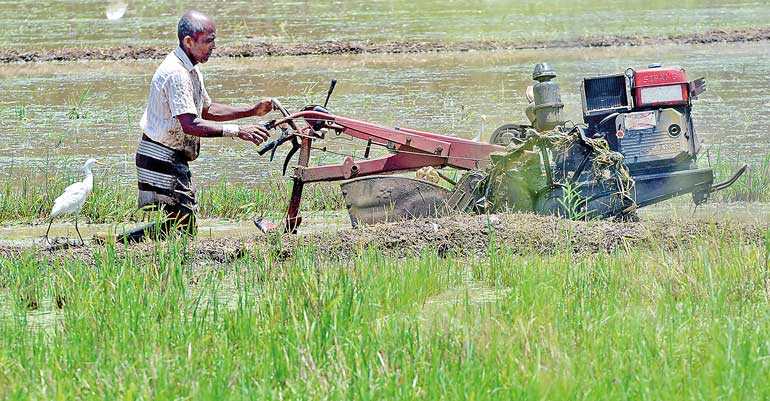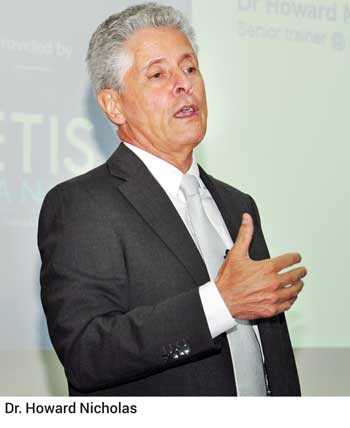Sunday Apr 06, 2025
Sunday Apr 06, 2025
Monday, 22 July 2019 01:30 - - {{hitsCtrl.values.hits}}

Drawing lessons from Vietnam’s experiences
The Sri Lanka-born economist attached to The Hague based Institute of Social Studies – Dr. Howard Nicholas – addressing a packed audience consisting of the alumni of the Postgraduate Institute of Management in Colombo last week gave a fine advice on how Sri Lanka should fast-track its economic growth. Drawing on the experiences of the recent economic development and predicted economic prospects of Vietnam, he conclusively declared that Sri Lanka’s future depends on its concentrating on producing exportable manufactured goods and not over-relying on agriculture or services.

Sri Lanka should go for exportable manufacturing goods
In summary, Nicholas’ thesis was as follows: Agriculture, specifically the plantation agriculture, has contributed enough to Sri Lanka’s economy in the past. But it has now come to its peak and any more development will not generate increased employment opportunities to Sri Lankans, a crucial issue which Sri Lanka has to tackle through accelerated economic growth. Similarly, services cannot take Sri Lanka further afar since, without a backing strong real sector, it cannot remain viable in isolation. Hence, the natural choice for Sri Lanka is to move into manufacturing because a society accumulates not agricultural products but manufactured products.
He gave a fine example to illustrate his point. In 1960s when he joined the college, he took all his belongings in a briefcase. But, now if he has to do the same, he has to carry with him truck load of goods which are all manufactured products. Hence, when income increases, the demand from the citizens is for manufactured products. Thus, a country should be able to produce and supply the same if it is to survive and prosper. But Sri Lanka’s market is small – it is only 21 million people – and therefore, it cannot absorb every manufactured product it may get to produce. Hence, it has to sell its products to the rest of the world which process is known as exports. Therefore, Sri Lanka has no choice, Nicholas opined, but to get into exportable manufactured product business.
This is heretic in a country where agriculture is worshipped like a religion. As such, Nicholas may run into challenge of and criticism by those Sri Lankans who still think that Sri Lanka should design its future by promoting its agriculture as the base of the economy. For them, Sri Lanka is an agriculture-based economy. To say otherwise is unpatriotic and a cardinal sin.
It is the Industry 4.0 that challenges Sri Lanka
In my article in this series last week, I also argued the same. The article titled ‘Sri Lanka’s future depends not on an outdated feudalistic system but on becoming a partner of a digital economy (available at: http://www.ft.lk/columns/SL-s-future-depends-not-on-outdated-feudalistic-system-but-on-becoming-partner-of-a-digital-economy/4-681935) argued that it is a myth to say Sri Lanka was an agriculture based economy in the past, it is so today and it should be the same in the future. In the past, Sri Lanka was, I argued, more a trading economy than an exclusively agriculture based economy.
During the British period, its plantation sector consisting of three tree crops – tea, rubber and coconuts – brought higher income to Sri Lankans. This trend continued till about late 1970s but beginning from early 1980, the economic structure got changed in favour of basically a single manufactured product, namely, textiles and garments. Accordingly, while agricultural output continued to increase in absolute terms, its dominance in the economy gradually shrank. In exports, tea, rubber and coconut had accounted for 90% of its earnings prior to 1977, but this ratio continued fall in the subsequent period. In 2018, their combined share in export earnings was just 15%. To take its place, the export earnings from industrial products continued to grow and in 2019, it brought in 79% of export earnings. Of those earnings, textiles and garments were responsible for 45%.
Sri Lanka as a nation has been anti-foreign, seeing ‘unseen conspiracies’ being hatched by them against this small island nation. Media is abuzz with such conspiracy stories, and even the more educated Sri Lankans fall victims to such sensational stories every day. Hence, before doing anything, the Sri Lanka Government should erase these paranoid beliefs from the minds of people if the country is to welcome foreign investors as friendly collaborators in the country’s march toward development.
In the national economy, of the total output, agriculture accounted for, on average, about 30% in 1970s. Though the agricultural output increased in absolute terms in the subsequent period, the output of industry and services increased faster than that of agriculture, pushing down its share to 8% of the total output by 2019.
Hence, I argued that there was a dramatic structural change in Sri Lanka’s economy in the past few decades, but that change has to take a different direction today, especially because of the new challenges faced by its main growth driver, textiles and garments, globally. Those challenges took the form of a call for the return of the industry to developed countries by locating factories on their soil – known as on-shoring or re-shoring – and in countries close to major markets – known as near-shoring. 
Thus, Sri Lanka has to find a new growth driver now and that growth driver comes in the form of ‘digital economies’ along with the new wave of industrialisation named the Fourth Industrial Revolution or Industry 4.0, a term coined by the convenor of the World Economic Forum, Klaus Schwab. Hence, it was argued that Sri Lanka should redesign its strategy to make Sri Lanka an active partner of the emerging global digital economy. Nicholas stopped short of making this recommendation.
Sri Lanka’s FDI drive has yielded a pittance in the past
Nicholas presented in his comparative analytics that Vietnam is already on to the Fourth Industrial Revolution by becoming a new tiger in East Asia. The secret of its doing so was to attract foreign direct investments or FDIs from other developed East Asian nations, namely, South Korea, Japan, Taiwan, and China. It did so by creating a social, political, economic and technological environment conducive to receive and harness FDIs.
This is where Sri Lanka had faltered though it was the first country to do so in early 1980s among the emerging South Asian nations. But Sri Lanka’s attraction of FDIs was a pittance compared to more successful other Asian nations. From 1950 to 1978, Sri Lanka’s attraction of FDIs was on average either negative or near zero. After the country went into the FDI strategy consciously, it was hovering around $ 50 million per annum till 1989. It took a sharp turn upward since 1990 maintaining it at an average level of about $ 600 million till 2016. In 2017, it broke the hitherto impossible threshold of $ 1 billion by mobilising about $ 1.3 billion and reached further high to $ 1.5 billion in 2018. Since most of these new FDIs were into the growing hospitality and the real estate sector, it is unlikely that this growing trend could be maintained unabated by Sri Lanka in the next few years.
Hence, like Vietnam, Sri Lanka has to find new avenues to attract more advanced FDIs to the country. Nicholas’ mission was to tell Sri Lankans the key learning points from the recent experiences of Vietnam.
Sad story of National Economic Council
FDIs will not come to a country on their own and they have to be managed carefully by policy authorities. In Sri Lanka’s case, the authority de jure is the Board of Investment which is empowered by law to attract, regulate and monitor FDIs into the country. However, the de facto policy authority until recently was the Cabinet Committee on Economic Management or CCEM, a loose organisational mechanism lacking transparency in its operations or direction with respect to where Sri Lanka’s economy should move forward. This was made defunct by a Presidential order in late 2017 and, in its place, a National Economic Council or NEC was set up with a wider membership in addition to those who had earlier served CCEM.
NEC was expected to come up with a comprehensive national economic plan taking into account the current state of the economy, emerging global developments and future strategies for Sri Lanka to generate prosperity to Sri Lankans, on the one hand, and driving Sri Lanka to a rich country within a shortest time possible, on the other. There was an announcement in the media that NEC was on to this job in mid-2018, but so far no such plan has emerged.
About 30 years ago, it was Singapore which was Sri Lanka’s benchmark country. Now Singapore has faded into oblivion since Sri Lanka cannot reach that country’s level even within a century. Ironically, a new country which was nowhere in the scene two decades ago has taken Singapore’s place. That country is Vietnam and Sri Lanka’s policy makers will have to follow its footsteps carefully if the country is to first recover from the economic depth to which it has fallen today and allow it to fast track as recommended by Nicholas
If one goes through the website of NEC (available at: http://www.necsl.gov.lk/ ), one could find reports about various meetings it had conducted to resolve fire-fighting micro issues relating to Sri Lanka’s economy. It had discussed the status of Sri Lanka’s economy some 10 months ago, solutions to the economic challenges nine months ago and the appointment of a committee to recover the badly hit tourism sector following the 4/21 bomb attacks some three months ago. In the download section, according to the website, one could download the Central Bank annual reports. It also appears that the website has come under cyber attack since, when one tries to log into a specific section, one is often redirected to an outside website announcing to the user that his IP address has been selected for a cash award and what action he should take to retrieve that cash award.
Thus, FDI management in Sri Lanka is like a ship without rudder or skipper floating in the rough seas with no direction. This is no good news for FDIs in Sri Lanka.
Vietnam’s proactive FDI policy
In contrast, Vietnam has always taken a forward look at FDIs. It goes by a well-laid strategy to attract FDIs in terms of the country’s economic priorities and the emerging global developments. In July 2018, its Ministry of Planning and Investment in collaboration with World Bank’s sister organisation, International Finance Corporation, came out with a document recommending strategies for attracting FDIs during 2020-30 which is a major component of the country’s socio-economic development strategy during the same period (available at: https://www.vietnam-briefing.com/news/vietnam-recommendations-fdi-strategy-2020-2030.html/).
According to this report, as at mid-2018, the total registered FDIs in Vietnam had totalled US $ 331 billion and of that, $ 181 billion or 55% had been disbursed. About 57% of that amount had gone into manufacturing and processing, while 17% to real estates. As at mid-2018, FDI sector had accounted for 22% of Vietnam’s GDP and 70% of its exports. The total job creation had been close to 10 million.
Since, like Sri Lanka, Vietnam is also facing the problem of the shortage of skilled labour and connection to supply chains, the new plan envisages to tackle the problem by investing heavily in developing a skilled labour force, modernising on investment promotion activities and focussing on priority sectors, ensuring the attraction of quality FDIs, opening the services sectors such as education, logistics and financial services to make them more competitive, promoting Vietnamese FDIs abroad, tackling the negative impact of the Fourth Industrial Revolution and developing backward and forward linkages with FDIs and local suppliers. The priority sectors that should attract FDIs in the next decade, according to the Government of Vietnam, will be high tech manufacturing, high tech farming, healthcare, travel and education that will elevate its economy to the status of a high tech producer in the globe.
Make foreign investors feel at home
About 30 years ago, it was Singapore which was Sri Lanka’s benchmark country. Now Singapore has faded into oblivion since Sri Lanka cannot reach that country’s level even within a century. Ironically, a new country which was nowhere in the scene two decades ago has taken Singapore’s place. That country is Vietnam and Sri Lanka’s policy makers will have to follow its footsteps carefully if the country is to first recover from the economic depth to which it has fallen today and allow it to fast track as recommended by Nicholas.
Singapore in its initial stage of attracting FDIs in 1960s and 1970s, took deliberate measures to convert the city state into a ‘Western Oasis’ so that foreigners would feel as if they are in their home countries. Two centuries ago, the Scottish planters in old Ceylon did the same by establishing a small Scotland in Bandarawela, Hatton and Nuwara Eliya. Vietnam has also done it now by developing different towns in Ho Chi Minh City catering to foreign investors. Accordingly, there are several Japan Towns, South Korea Towns, Taiwan Towns and China Towns in the city with schools, restaurants, hospitals, apartments and so on catering to the needs of the respective investors.
Its motto has been ‘Keep investors happy and it will make Vietnamese too happy’. Sri Lanka as a nation has been anti-foreign, seeing ‘unseen conspiracies’ being hatched by them against this small island nation. Media is abuzz with such conspiracy stories, and even the more educated Sri Lankans fall victims to such sensational stories every day. Hence, before doing anything, the Sri Lanka Government should erase these paranoid beliefs from the minds of people if the country is to welcome foreign investors as friendly collaborators in the country’s march toward development.
The writing on the wall is now clear: If Sri Lanka misses this opportunity, it will never be able to catch up with the rest of the world.
(The writer is a former Deputy Governor of the Central Bank of Sri Lanka and could be reached at [email protected].)